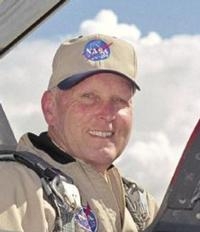Logged 382 Hours In Space On Two Shuttle Missions
C. Gordon Fullerton, who compiled a distinguished career as a NASA astronaut, research pilot and Air Force test pilot spanning almost 50 years, died Aug. 21. He was 76. Fullerton had sustained a severe stroke in late 2009, and had been confined to a long-term care facility in Lancaster, CA, for most of the past three and a half years.

Fullerton logged 382 hours in space flight on two space shuttle missions while in the NASA astronaut corps from 1969 to 1986. He then transferred to NASA's Dryden Flight Research Center at Edwards Air Force Base, where he served for 22 years as a research test pilot on a variety of high-profile projects. During the latter years of his career at NASA Dryden, he served as Associate Director of Flight Operations and as chief of the directorate's flight crew branch prior to his retirement at the end of 2007.
A native of Portland, OR, Fullerton earned bachelor's and master's degrees in mechanical engineering from the California Institute of Technology and then joined the U. S. Air Force in 1958. After assignments flying both fighters and bombers, Fullerton attended the Air Force Aerospace Research Pilot School at Edwards in 1964. After two years as a test pilot at Wright-Patterson Air Force Base in Ohio, he was selected for the Air Force Manned Orbiting Laboratory program in 1966. Following cancellation of that program in 1969, Fullerton was assigned by the Air Force to NASA's astronaut corps at the Johnson Space Center. Fullerton served on the support crews for the last four Apollo lunar missions, and was part of one of two crews who flew the space shuttle prototype Enterprise during the Approach and Landing Test program at NASA Dryden in 1977.
Fullerton flew into space on the space shuttle Columbia during the eight-day STS-3 orbital flight test mission in March 1982. That mission became the only shuttle mission to land at White Sands, NM, because Rogers Dry Lake at Edwards was flooded by heavy seasonal rains. He then commanded the shuttle Challenger on the STS-51F Spacelab 2 mission in 1985. That flight carried 13 major experiments in the fields of astronomy, solar physics and life and materiel science.
At NASA Dryden, Fullerton was the project pilot on the NB-52B launch aircraft, flying initial launches of the Pegasus rocket, the X-38 Crew Recovery Vehicle and the hypersonic X-43A. He was pilot-in-command of NASA's modified Boeing 747 Shuttle Carrier Aircraft on numerous ferry flights of space shuttles from Edwards to the Kennedy Space Center.
Fullerton flew numerous other research programs at Dryden, including the F-15 and MD-11 Propulsion Controlled Aircraft project, and was project pilot for high-speed landing tests of space shuttle landing gear components installed on a modified Convair 990 jetliner. He flew NASA's DC-8 Airborne Science laboratory worldwide on a variety of environmental research studies, and flew the first test flights of NASA's Stratospheric Observatory for Infrared Astronomy. He was also one of only two non-Russian pilots to fly the Tu-144 supersonic transport.
Fullerton retired from the Air Force with the rank of colonel after 30 years of active duty in 1988. He piloted more than 135 different types of aircraft during his Air Force and NASA career, amassing more than 16,000 flight hours. He was honored with numerous civil and military awards during his career. He was inducted into the Astronaut Hall of Fame in 2005, the International Space Hall of Fame in 1982 and was a Fellow of the Society of Experimental Test Pilots.
Funeral arrangements are pending at Halley-Olsen-Murphy Memorial Chapel in Lancaster. A funeral mass is scheduled for 10 a.m. Saturday, Aug. 24, at Sacred Heart Catholic Church in Lancaster, followed by a celebration of Fullerton's life at NASA Dryden on Monday, Aug. 26, beginning at 10 a.m.
(Image provided by NASA)
 Senator Pushes FAA to Accelerate Rocket Launch Licensing
Senator Pushes FAA to Accelerate Rocket Launch Licensing Classic Aero-TV: RJ Gritter - Part of Aviations Bright New Future
Classic Aero-TV: RJ Gritter - Part of Aviations Bright New Future Aero-FAQ: Dave Juwel's Aviation Marketing Stories -- ITBOA BNITBOB
Aero-FAQ: Dave Juwel's Aviation Marketing Stories -- ITBOA BNITBOB ANN's Daily Aero-Linx (10.27.24)
ANN's Daily Aero-Linx (10.27.24) ANN's Daily Aero-Term (10.27.24): Clearance Void If Not Off By (Time)
ANN's Daily Aero-Term (10.27.24): Clearance Void If Not Off By (Time)



